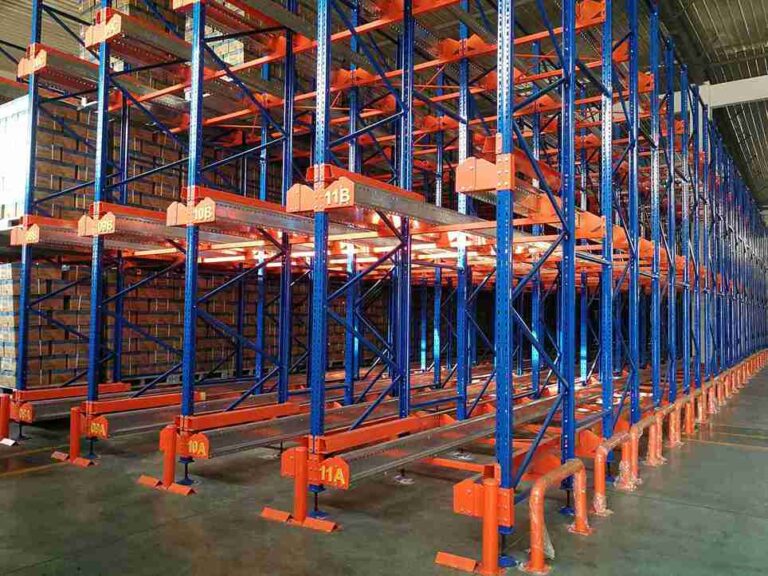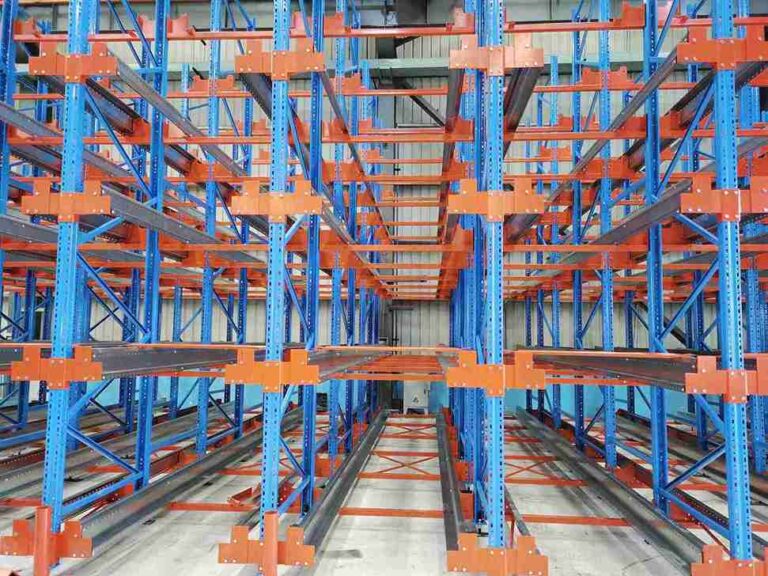📐 "First 50 Enterprise Queries Get Custom 3D Warehouse Design" Plan

The Critical Role of Shuttle Racking in Today’s Supply Chain
In an era where warehouse efficiency directly impacts profitability, the shuttle racking system has emerged as a transformative solution for businesses seeking to optimize their storage operations. With its unique blend of automation and high-density storage capabilities, this system presents both remarkable advantages and disadvantages that warehouse managers must carefully evaluate.
The growing adoption of shuttle racking systems across industries like food distribution, pharmaceuticals, and e-commerce underscores their importance. However, without a thorough understanding of both the benefits and limitations of these systems, companies risk making costly investments that may not align with their operational needs.
This definitive guide provides an unbiased, expert-level examination of shuttle racking system advantages and disadvantages, offering warehouse operators the insights needed to make informed decisions. Drawing from real-world case studies and industry benchmarks, the analysis goes beyond surface-level features to explore practical implementation considerations. shuttle racking system advantages and disadvantages very important.

1. Understanding Shuttle Racking System Fundamentals
1.1 Core Components and Operational Mechanics
The shuttle racking system consists of three primary elements that work in concert to deliver its functionality:
Storage Structure: Heavy-duty steel frames designed for deep-lane storage, typically accommodating 5-30 pallets per lane
Motorized Shuttles: Battery-powered vehicles that travel on rails within storage lanes, capable of handling loads up to 1,500 kg
Control System: Software interface that manages shuttle movements, inventory tracking, and retrieval sequencing
Unlike conventional systems requiring forklift entry, the shuttle racking system operates on a “goods-to-operator” principle. When a pallet reaches the lane entrance via forklift or conveyor, the shuttle automatically:
Positions itself at the lane entrance
Engages with the pallet’s underside
Transports it to the optimal storage position
Returns to the entrance when summoned for retrieval
1.2 Key Variations in System Design
Modern shuttle racking systems offer several configuration options to meet diverse operational needs:
Single-Depth vs. Multi-Depth: Single-depth systems allow direct access to every pallet, while multi-depth configurations maximize storage density
Semi-Automated vs. Fully Automated: Semi-automated versions require manual shuttle positioning, while fully automated systems integrate with WMS for hands-off operation
Ambient vs. Cold Storage Models: Specialized versions maintain functionality in freezer environments as low as -30°C
These variations significantly impact both the advantages and disadvantages experienced in real-world applications, making proper system selection crucial.
2. The Five Transformative Advantages of Shuttle Racking Systems
2.1 Unparalleled Storage Density Optimization
The most celebrated of all shuttle racking system advantages is its ability to dramatically increase storage capacity. By eliminating the need for forklift aisles between every storage lane, these systems typically achieve:
75-90% floor space utilization compared to 40-50% with selective racking
Up to 60% more pallet positions within the same warehouse footprint
Vertical storage heights reaching 45m in specialized installations
For urban fulfillment centers facing extreme space constraints, this density advantage alone often justifies the investment in shuttle racking systems.
2.2 Operational Efficiency Breakthroughs
Beyond space savings, the shuttle racking system delivers measurable productivity gains:
3-5x faster pallet movements compared to manual forklift operations
Precision placement with <5mm positioning accuracy
Continuous operation capability with quick-change shuttle batteries
These efficiency advantages translate directly to labor cost reductions, with many operations reporting 30-40% decreases in staffing requirements for storage/retrieval functions.
2.3 Enhanced Inventory Control and Accuracy
The automated nature of shuttle racking systems introduces new levels of inventory management precision:
Real-time pallet tracking through integrated WMS connectivity
Elimination of misplacement errors common in manual systems
Automated stock rotation enforcing FIFO or LIFO protocols
For regulated industries like pharmaceuticals, these control advantages provide compliance assurance that manual systems simply cannot match.
2.4 Improved Workplace Safety Metrics
Among the most valuable shuttle racking system advantages is its safety performance:
85% reduction in forklift-related accidents
Elimination of high-risk deep-lane forklift maneuvers
Reduced worker fatigue from decreased manual handling
These safety improvements frequently lead to lower insurance premiums and workers’ compensation costs, further enhancing ROI.
2.5 Long-Term Cost Competitiveness
While the upfront investment is substantial, the shuttle racking system delivers compelling lifetime economics:
5-7 year payback periods in high-volume operations
20-30% lower operating costs versus traditional systems after year 3
15-20 year service life with proper maintenance
For growing operations, these financial advantages make shuttle systems a strategically sound capital allocation.
3. The Five Critical Disadvantages of Shuttle Racking Systems
3.1 Substantial Capital Requirements
The most significant of all shuttle racking system disadvantages is the initial investment:
$100-$300 per pallet position depending on automation level
$500,000+ for medium-sized installations
Additional costs for structural reinforcements, electrical work, and WMS integration
These figures place shuttle systems beyond reach for many small to mid-sized operations without access to significant capital.
3.2 Inflexibility for Dynamic Inventory Profiles
Certain operational realities amplify shuttle racking system disadvantages:
Minimum 10-15 pallets per SKU for economic viability
Poor suitability for SKUs with highly variable dimensions
Slow adaptation to inventory mix changes
Operations with highly seasonal or rapidly evolving product lines often find these constraints prohibitive.
3.3 Technical Complexity and Maintenance Demands
The sophisticated technology behind shuttle racking systems introduces new challenges:
Specialized technicians required for repairs
2-4 week lead times for replacement parts
Ongoing software updates and system recalibrations
Without proper technical support infrastructure, these disadvantages can lead to costly operational disruptions.
3.4 Throughput Limitations in Certain Configurations
Not all shuttle racking systems deliver equal performance:
Single-shuttle systems may create bottlenecks during peak demand
Deep-lane configurations slow retrieval times for rear-positioned pallets
Peak throughput typically capped at 50-70 pallets/hour per aisle
High-volume operations must carefully model these constraints during system design.
3.5 Climate Control Complications
In environmentally sensitive applications, shuttle racking system disadvantages emerge:
Battery performance degradation in extreme temperatures
Condensation issues when moving between temperature zones
Increased maintenance frequency in humid or corrosive environments
Specialized equipment modifications can mitigate but not eliminate these challenges.
4. Comparative Analysis: Shuttle Racking vs Alternative Systems
4.1 Shuttle Racking vs. AS/RS: The Automation Spectrum
While both systems offer automation advantages, key differences exist:
AS/RS provides higher throughput (100+ pallets/hour) but at 2-3x the cost
Shuttle systems offer better ROI for operations with <50 pallet movements/hour
Hybrid solutions are emerging that combine technologies
4.2 Shuttle Racking vs. Drive-In Racking: Density vs Accessibility
The density advantages of shuttle systems come with tradeoffs:
Drive-in racking allows faster access to all pallets
Shuttle systems provide better inventory control and rotation
Damage rates are typically lower with shuttle systems
4.3 Shuttle Racking vs. Mobile Racking: Flexibility Comparison
Mobile racking systems present an interesting alternative:
Mobile racking offers greater layout flexibility
Shuttle systems provide superior automation capabilities
Operational costs favor shuttle systems in high-volume scenarios
5. Implementation Considerations for Maximum ROI
5.1 Warehouse Layout Optimization Strategies
To maximize shuttle racking system advantages:
Aisle width must balance shuttle access and storage density
Picking zones should be strategically positioned
Future expansion pathways must be preserved
5.2 Workforce Training Requirements
Mitigating shuttle racking system disadvantages requires:
Dedicated system operators with technical training
Maintenance personnel certified on shuttle mechanics
Management training on performance analytics
5.3 Integration with Existing Systems
Successful implementations address:
WMS compatibility through API development
Legacy equipment interface requirements
Data reporting standardization
6. Future Trends in Shuttle Racking Technology
6.1 AI-Driven Predictive Maintenance
Emerging solutions are addressing shuttle racking system disadvantages:
Vibration sensors detecting impending failures
Usage pattern analysis optimizing maintenance schedules
Self-diagnosing shuttle units
6.2 Advanced Energy Recovery Systems
New designs enhance sustainability advantages:
Regenerative braking energy capture
Solar-assisted charging stations
Low-temperature battery innovations
6.3 Modular Expansion Capabilities
Future-proofing strategies include:
Plug-and-play shuttle additions
Hot-swappable component designs
Scalable control architectures
7. Conclusion: Making the Right Storage Automation Decision
The comprehensive analysis of shuttle racking system advantages and disadvantages reveals a solution that is neither universally perfect nor universally problematic. For the right operation – typically those with stable, high-volume pallet flows and sufficient capital – the advantages can be transformative. However, the disadvantages demand careful consideration and mitigation planning.
Key decision factors should include:
Pallet volume consistency
Available capital and ROI requirements
Existing workforce technical capabilities
Future growth projections
For operations where the shuttle racking system aligns well, the potential benefits in density, efficiency, and safety frequently justify the investment. Those considering implementation should engage with experienced consultants to conduct detailed feasibility studies before proceeding.The shuttle racking system advantages and disadvantages systems are important to the efficiency of your warehouse use.shuttle racking system advantages and disadvantages to understand clearly.
8. Frequently Asked Questions (FAQs)
8.1 Can shuttle racking be used in narrow-aisle warehouses?
Yes, but proper aisle width calculations are needed for shuttle movement.
8.2 What’s the lifespan of a shuttle racking system?
With proper maintenance, 15-20 years.
8.3 How much does a basic shuttle racking system cost?
Starting at $50,000, scaling up based on automation level.
8.4 Is shuttle racking better than pallet flow systems?
Depends on inventory turnover—pallet flow is better for fast-moving goods.
8.5 Can existing racking be converted into a shuttle system?
Sometimes, but structural modifications may be required.
Welcome to contact us, if you need warehouse rack CAD drawings. We can provide you with warehouse rack planning and design for free. Our email address is: jili@geelyracks.com




